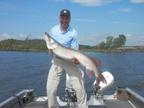
Posts: 3508
Location: Elk River, Minnesota | Hiya,
The first thing to consider is where are the RPM's when the boat is loaded with just you and your gear. If, when loaded this way you are under your max RPM, there is work that can be done, which may or may not mean getting the prop reworked.
In most circumstances, the standard motor mounting is one bolt up off the transom, which usually puts the anti-ventilation plate at or slightly above the lowest point on the transom. For most boat owners, this set-up allows for decent speed, and good handling and is best for aluminum props as they usually will not perform well at higher motor heights.
I am assuming here since you have vent holes in your prop, you are running steel...on that rig, I would say that is a good thing, and usually will allow you to play around with motor height to some extent, given the prop has a good trailing edge cup on the fins.
A couple of things come to mind...first and foremost, if you can do a quick test on how well the rig runs when lightly loaded in terms of speed, handling and hole shot, we can see what options might be available to get a more efficient rig.
In most cases, a good steel prop that has decent rake and cup will help the bow out tremendously, while lifting the entire rig out of the water. For bow lifting capabilities, a good amount of rake (the angle the blade meets the hub) will help lift the bow as will tip cupping on the blades. Trailing edge cup will help lift the stern, thus when combined will lift the whole boat more and maintain good handling capabilities. The nice thing here is the operator can usually raise the motor a bolt hole or two, or even 3 if possible to gain more speed and rpm without a major loss in handling. For every inch you go up in motor height, you will see about a 100 RPM increase.
When the combination is found (motor height, prop, optimum RPM etc) the motor will just seem to float along at cruising speeds and yet still have the "umph" for low end hole shot and optimum top speed.
No matter what, though, propping and finding a good set-up for your use is an exercise in being able to compromise.
If you can start with the basic numbers, then a plan of options can be considered.
Steve
|





